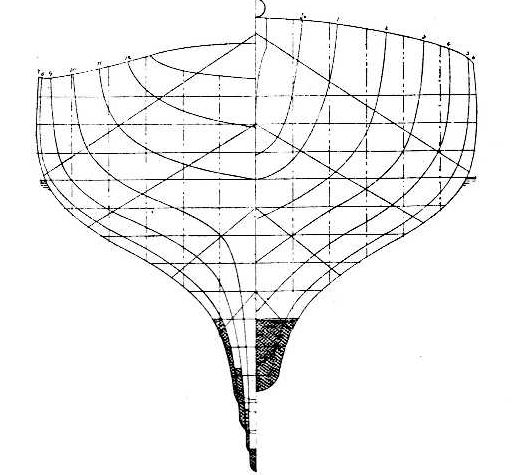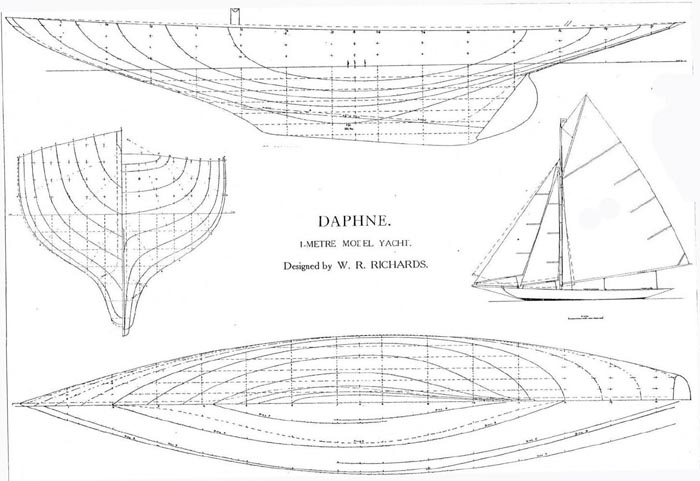|
The YRA was still dissatisfied with the Second Linear
rating Rule and its Secretary, Brooke Heckstall-Smith, noting that the French
and some other nations were looking to revise their Rules, suggested an international
conference that would seek to produce a Rule acceptable to a wide range of
nations, facilitating international competition. The conference met in two
sessions in London and one in Berlin in 1906 and the result was the First
International Rule, finally promulgated in October 1906, to come into effect
in the UK in January 1907 for classes at 23, 19, 12, 10, 9, 8, and 6 metres.
January 1908 was specified for the introduction of the Rule for classes at
15, 7, and 5 metres, because these would correspond to the existing LRR classes
at 52, 24 and 18 feet LRR. Races for LRR classes would continue until the
end of the 1908 season and combined fleets of metre boats and LRR boats would
race at the three latter sizes.
The Rule in its full size form had complex scantling requirements
and specified levels of accommodation in the larger sizes of yacht as well.
The result was to produce very heavily built and relatively expensive boats,
described by those who preferred the lightly built yachts of the preceding
Rule as 'floating wood yards' and 'perambulators'. The application of the
scantlings rules was entrusted to Lloyds Register, who found themselves supervising
the building of small open racing yachts.
The formula was:
Rating in Metres =(L + B .5G + 3d + .33 S1/2
- F)/2
Note: S1/2
is the square root of S. The conventional symbol is not available on
the webpage.
L was the waterline length, but measured a short distance above the
load waterline, to give a more realistic representation of the sailing
length, and further adjusted by bow and stern taxes based on the differences
between girths and freeboard at the bow and stern measurement points
for L. These were intended to encourage seamanlike V-sectioned ends
rather than the U-shaped or flat ends that were regarded as 'unwholesome'.
| The bow and stern taxes. Though intended to
control the shape of the ends, they were not entirely successful in practice.
|
B was the beam at the widest point.
G was a chain girth, waterline to waterline, at the 55%
point on the waterline.
d was a girth difference between the chain
girth and a skin girth at the measurement point. It was multiplied by three,
rather than four, as in the preceding LRR.
|
|
|
The concept of girth difference, 'little d'
|
F was an average of freeboard measurements at the three
measurement points of the waterline.
S was the sail area, measured as the whole of the cloth
for the mainsail and topsail and as the whole of the fore triangle representing
the headsails. Spinnakers or square sails used for downwind work could not
exceed the area of the fore triangle.
There is some confusion over whether the model version
of the Rule incorporated all the provisions of the full size Rule. Clearly
scantlings and accommodation requirements did not apply, but the first models
to the Rule were built by members of the London MYC before the foundation
of MYRA (and before even the formal acceptance of the full size Rule by the
IYRU), and, given the interest and attitudes of the members, would almost
certainly have followed the Rule to the letter. After the foundation of MYRA
in 1911, the 12-metre at 1 inch to the foot was adopted as one of the national
classes and a model Rule was promulgated. As this Rule is set out in Hobbs's
book of 1923, it makes provision for bow and stern taxes to be applied to
the measurement of L, but not for that measurement to be taken above the actual
waterline. Other statements of the model version of the Rule also make no
mention of adjusting the L measurement in this way and the calculation of
the rating, included with the drawing of Giles's 12-m design Dot, shows that
the lwl was used rather than any adjusted measurement. Similarly, Alfred Turner's
discussion of design to the International Rule in Yachting Monthly during
the First World War makes much of the effect of the lack of bow and stern
taxes in the similar Continental 80 centimetre Rule, but accepts measurement
of the lwl on the actual waterline.
It is hard to understand why the MYRA chose to depart
from full size practice in this respect, as the measurement above the waterline
was no more difficult than the 'little d' and bow and stern taxes, which they
adopted. The London club were noted as being only too pleased to have a really
complex Rule on which to exercise their designing talents. They were the originators
of the dry measurement frame that became an essential part of serious model
yacht measurement for the A Class in the 1920s and later.
The Rule was not dissimilar in intent, and in effect,
to the LRR that preceded it, but in models, even more than in the full size
craft, produced heavy, barrel-like hulls and excessive sail areas. A selection
of designs is shown below.
|
|
|
|
|
This is Alderman one of the
very first model designs to the Rule, by E R Tatchell of the London
MYC. She was sailed by his son Percy, the London MYC Secretary. Notice
the very long gunter yard, with a brace to keep it more or less straight
|
 |
|
|
|
|
|
This is Sphinx a design by Willmer of the Wirral club
that competed in one of the London's early open races for the class.
The rig is a conventional gaff sloop with topsail.
|
 |
|
Daphne, an early 12-m design
by Bill D.aniels. In this publication in The Yachtsman, the design is
attributed to Richards, an older man with whom Bill set up in partnership
as professional model builders. After Richards' death in 1909, the design
was universally attributed to Daniels. A similar joint attribution was
made for the 10-rater XPDNC when she first appeared, but there is little
doubt that she, like Daphne, was essentially by Daniels.
|
The first models to the Rule were built and sailed in
competition by The London MYC which contained several designers of full size
craft including Tommy Glen-Coats and E R Tatchell. The first open race for
boats to the new Rule was held on the Round Pond in March of 1907, before
any full size craft to the Rule had been completed. Designated as '1-metre'
boats to the International Rule, the fleet had three boats designed by Glen-Coats,
three by Tatchell and three by John Odgers, a member of the MYSA club that
shared the water, though not the social pretensions, of the London.
The London took themselves and their contribution to the
advance of naval architecture very seriously. Their young and enthusiastic
Secretary, Percy Tatchell suggested that full size designers might have their
designs tested by allowing London members to build and sail models of them.
This was not taken up by any designers outside the London itself. Glen-Coats
progressed rapidly from designing '1-metre' models to designing the first
two full size 12-m to be built in Britain, one for himself and one for his
uncle. He won a gold medal in the 1908 Olympic Games with his boat Hera. John
Odgers, a building surveyor and member of the 'working men's club' at Kensington
also designed full size boats, winning design competitions run by The Yachtsman
and designing a 7-metre Heroine for Charles Rivett-Carnac, a retired Indian
Civil Servant and member of the London. This boat turned out to be the dog
of the 7-m and 24 foot LRR fleet on the Solent but was entered for the Olympic
regatta. The only other entry, Mignonette, a much better boat, was damaged
in the week before and could not be repaired in time, so Heroine sailed over
for the gold medal. This was the first (and last) time that Olympic medals
had been won by model yachtsmen. Rivett-Carnac's wife Clytie, who was part
of his amateur crew, became the first woman to compete in an Olympic event
and won a gold medal as well. The boat did not race after 1908 but was converted
for cruising and was still on the Lloyd's Yacht register in 1945.
The Wirral club was another stronghold of the Rule. At
a meeting in 1907 they decided by a very narrow majority of their 60 or so
members that LRR boats would be permitted to compete until the end of the
1907 season, but that by the beginning of 1908 only International Rule boats
would be accepted in the club. There were groups of metre boats on the South
coast at Southsea and Poole and another strong club in London, the Alexandra
which sailed on the water in Victoria Park. The club suffered a disastrous
boathouse fire in 1908 and took the opportunity to commit themselves to the
International Rule, buying many of the first generation 12.metre boats from
the London club.
The total number of boats built to the Rule is not known
because there was no central register and, in any case, all MYRA and MYA records
before 1925 have been lost, but it must have been substantial as the MYRA
made the 12-m one of its national classes and held the first national championship
for the class in 1912. Boats were also built in 10 and 8-m sizes, but it is
not clear that there were ever enough of these to provide regular competition.
Interestingly, there were no 6-m models to the International Rule, possibly
because the idea of the 1 inch to the foot scale had too great a hold.
There are a fair number of designs still surviving and
a small number of boats. Only one that I know of is (or was) in sailing condition,
the zebra planked example below. She was recovered from the back of the boathouse
in Dundee and restored and radioed as part of the club's centenary celebrations
in 1985.
|
|
|
The only 1906 Rule 12-m known
to be in sailing condition. The rig is of course of later date.
|
The 12-m came in just about the time that Braine gear
was beginning to be used, but some boats retained weighted rudder or weighted
tiller steering. They were big and heavily canvassed boats and the largest
weighted rudder, used for down wind runs in heavy weather, might weigh as
much as two pounds. Weighted tiller gears of some sophistication were used,
as seen in the example pictured of an 8-m. You can see why they needed heavy
rudders.
|
|
|
8-m Elizabeth steering gear
|
|
|
|
12-m running.
|
|
